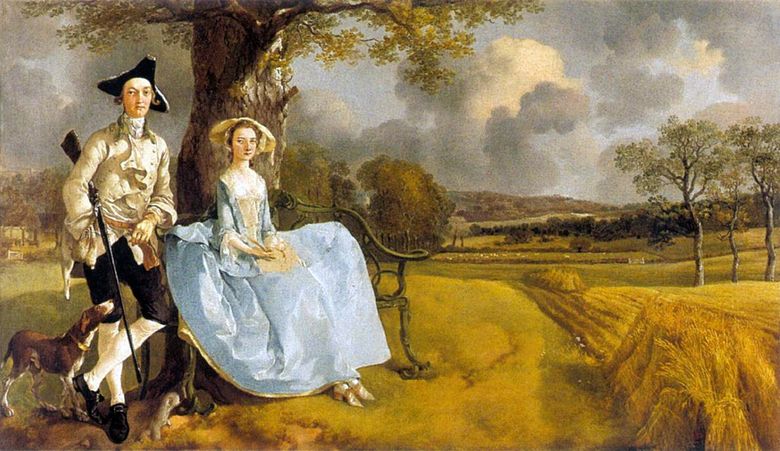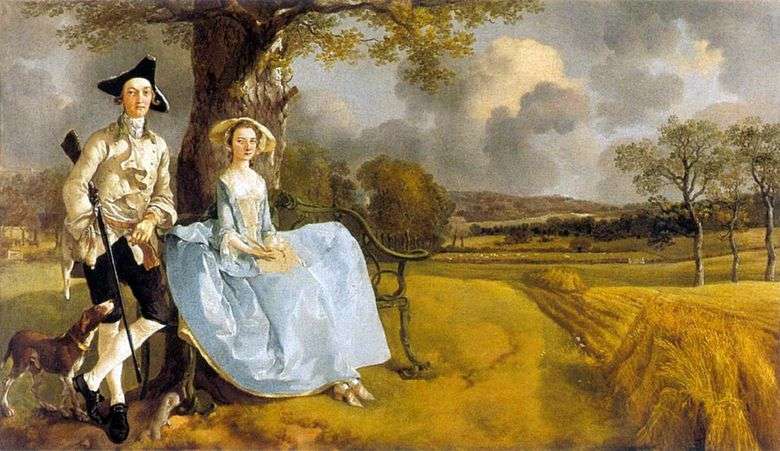
Mr. and Mrs. Andrews, sealed by Gainsborough, owned a large estate near Sedbury, the artist’s hometown. Their portrait he wrote shortly after his return to Suffolk from London. It should be noted that the landscape in this composition plays no less important role than the actual portrait of the Andrews spouses – he Gainsborough gives more than half of the canvas.
However, the customers had nothing to be offended – in fact the painter pressed them not for some abstract landscape, but for their own estate. Robert Andrews, it seems, has just returned from hunting. He stands leaning casually on the back of the bench on which Francis Mary, his young wife, sits. Notice that one piece of her dress remained unfinished. Probably, the artist intended to portray in the hands of Mrs. Andrews a bird brought by her husband from the hunt, but then for some reason abandoned this intention.
The Andrews spouses look directly at the viewer, but there is one character in the portrait who does not pay attention to the viewer – this is Mr. Andrews’ hunting dog, devotedly looking at his master. In the “Portrait of Mr. Andrews with his wife” organically combines the two genres that made up the glory of Gainsborough – portrait and landscape. As for the latter, it is written with an accuracy unusual for the hero of our release and, if I may say so, topographic accuracy. For example, the white tower, visible far away, behind the trees, is a very concrete tower of the church of St. Peter, where in 1748 Mr. and Mrs. Andrews were married. Working on the “Portrait of Mr. Andrews with his wife,” Gainsborough first depicted the figures of people, and then the landscape.
It is curious that the artist himself painted only the faces from the customers. Their postures and dresses, he finished in his studio – with the help of mannequins, dressed properly. It must be said that Gainsborough always wrote draperies on his own, “out of my head.” Working with the model he did not need it. The more amazing is his ability to convey the texture of the fabric and place its folds in the most natural way – so that not one, even the most sophisticated, spectator would be able to suspect that these folds, shadows and glare are the product of the master’s imagination.
It is very skillful, for example, the blue dress of Mrs. Andrews is written. The artist remarkably managed to transfer the shine and coolness of the satin fabric to the canvas.
 Mr. and Mrs. Andrews by Thomas Gainsborough
Mr. and Mrs. Andrews by Thomas Gainsborough Morning Walk by Thomas Gainsborough
Morning Walk by Thomas Gainsborough Portrait de M. Andrews avec sa femme – Thomas Gainsborough
Portrait de M. Andrews avec sa femme – Thomas Gainsborough Portrait of Eneaj Lloyd with Sister Lucy by Thomas Gainsborough
Portrait of Eneaj Lloyd with Sister Lucy by Thomas Gainsborough Retrato de Mr. Andrews con su esposa – Thomas Gainsborough
Retrato de Mr. Andrews con su esposa – Thomas Gainsborough William Pointe of Midgehem and his dog Amber by Thomas Gainsborough
William Pointe of Midgehem and his dog Amber by Thomas Gainsborough A cart with a harvest by Thomas Gainsborough
A cart with a harvest by Thomas Gainsborough Portrait of Mrs. Graham by Thomas Gainsborough
Portrait of Mrs. Graham by Thomas Gainsborough